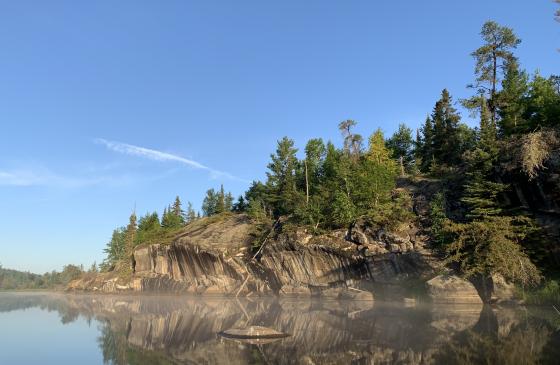Northeastern Minnesotans for Wilderness’ Economic Community Development Task Force recently published a report on their critical economic development findings regarding the Wilderness-edge town of Ely, Minnesota.
Getting a Sense of the Boundary Waters
Surrounding Ely, the 1.1 million-acre Boundary Waters Canoe Area Wilderness includes over 1,200 miles of canoe routes, on over a thousand lakes, teaming with game species. Two thousand remote campsites provide a retreat into a pristine state without motors or roads. Ely also abuts 2.5 million acres of Superior National Forest, public land notable for its boating and hiking opportunities.
As many of you know, the region is known for the boreal forest and varied ecosystems, home to a diverse array of animals. But did you know that Northern Minnesota is the last stronghold of the Gray Wolf in the lower 48 states? Lynx, bobcats, pine martens, and beavers are other mammals found throughout the woods. While black bears roam the forest and graze on the robust blueberry crops in July. Hunters pursue whitetail deer and grouse in the autumn, and bird enthusiasts are captivated by the haunting call of a loon, streaming across a lake. These experiences are unforgettable.
While the region is famous for summer activities, the lakes and woods are just as much alive in winter. After it snows, outdoor enthusiasts are actively ice fishing, dogsledding, ice skating, snowshoeing, snowmobiling, cross-country skiing, downhill skiing, and winter camping.
The Boundary Waters is a designated International Dark Sky Sanctuary - one of only 14 in the world. There the stars shimmer brighter, the Milky Way is more vivid, and the chances of seeing the Northern lights is more likely without the negative impacts of light pollution impacting the sky.
A Diversified Economy in Northeast Minnesota
Nationally, over the past two decades, outdoor recreation and recreation amenities, especially Wilderness amenities, have been the basis for economic growth in rural areas. Eligible local economies have moved away from traditional extractive industries and manufacturing, into services and recreation as the primary engines of economic development. A diversified economy built on the region’s natural assets – clean air, clean water, scenic beauty, and recreational opportunities – is deeply embedded in the fabric of life near the Boundary Waters.
In 1970, 10% of jobs and 15% of income earned in the Arrowhead region of Northeastern Minnesota were in the mining industry. While by 2018, mining accounted for only 2.9% of jobs and 6.4% of total payroll in the region. A Twin Metals mine would not significantly increase the share of employment and income in the mining sector. In fact, a recent study suggests gains would be short-lived and quickly overtaken by the project’s negative impact on recreation industries and in-migration. The Boundary Waters region would be better off continuing its diversified, amenity-based model of development.
Regional Demographics
The Ely area is experiencing increased in-migration by a growing mix of creative class workers, outdoor enthusiasts, entrepreneurs, professionals, retirees, trade and service sector workers, and anyone working remotely; almost 15% of residents are new to the area in the last year. A 2014 study of attitudes in the four townships surrounding Ely asked residents what qualities attracted them to the area. The vast majority spoke of the proximity to nature, outdoor recreational opportunities, solitude, and peace and quiet as the primary factors.
Families comprise over 55% of households in the Ely area. Of these, approximately 17% have children under 18. The Ely school district provides K-12 education to over 550 students in the City of Ely and surrounding townships.
More than one-third of the adult population in the Ely Area has a bachelor’s degree or above -- almost twice the rural America average. Over 50% of households have incomes greater than $50,000, and approximately two-thirds of those homes are owner-occupied. A recent study by the Center for Rural Policy and Development documents the lower cost of living in the Arrowhead region when compared to more urban areas; wages go farther in greater Minnesota.
Quality of Life
Ely area residents have a 1.1 million acre backyard. Exposure to nature has a positive impact on human health and vitality. That is, more time in nature leads to positive social, psychological, and physical health outcomes.
New residents can channel their interests through participation in the region's robust social and philanthropic networks. There are over 100 clubs and nonprofit organizations in the Ely area, and Ely’s exciting repertoire of festivals and celebrations means an even greater number of opportunities for community engagement. Notably, as quoted in an archived Ely Summer Times, “For a small town Ely is big on art.” Arts programming not only provides space for meaningful interaction but also cultivates value within individual participants.
The history of Ely is vibrant, well documented, and honorably sustained. A book with many chapters and a remarkable cast of characters, representing a diversity of thought that contradicts commonly adopted notions and rural stereotypes. The time is ripe for a rural revival, and northeastern Minnesota is the place to be.
